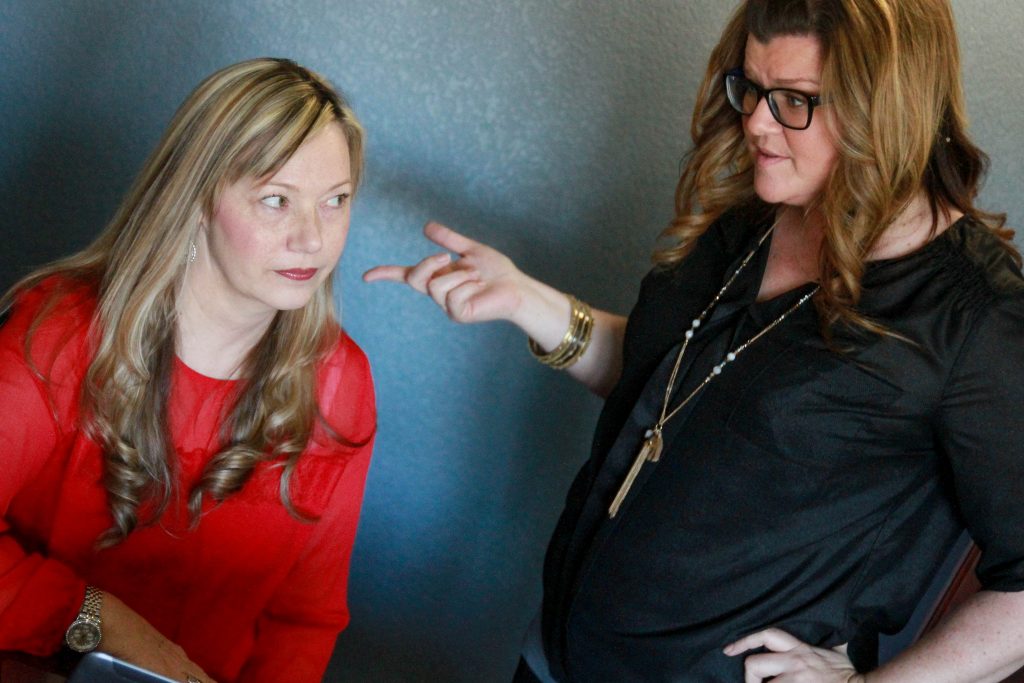Photo by Bernard Hermant on Unsplash
Not long ago I set a lunch meeting with a school official to discuss the youth life coaching program I direct. At the last minute I invited a business colleague to join us. The school official had a quiet and subdued personality, so I was grateful that my colleague, who is outgoing and easily carries conversations, accepted the invitation. I sat there in a bit of wonder as I watched him effortlessly engage in conversation with great questions and unforced humor.
Then I sat there in a bit of panic as he excused himself from the meeting to head off to another obligation. The next 20 minutes included multiple awkward silences, fumbled words, and the pervasive sense that I was just grasping at things to say. The lunch meeting ended okay, but I left frustrated with myself. I tried to reflect on what my colleague said and how he said it but couldn’t find anything that I knew I’d be able to replicate.
My frustration at that episode was exaggerated by the fact that I train and coach others on interpersonal communication. I knew what to do, but something about that conversation combined with the demeanor of the school official, had me discombobulated.
Since that day, I’ve worked out some insights that I think will be helpful if you find yourself (as I have) awkwardly tripping through conversations, frozen and panicked, or beating yourself up for those you’ve labeled as failures.
First, push back at your self-consciousness
When the primary thing in your awareness is your feeling of discomfort, your natural response will be to do whatever you can to alleviate that feeling. Finding the nearest conversational exit and shifting into hyper chatter are common alleviating efforts. Chatter never works, and quick exits forfeit the opportunity to figure out a way forward.
Self-consciousness will push your discomfort into the dominant position, preventing you from focusing on the objectives of the conversation, or the needs, interests, and concerns of the other participant. When you become aware of your self-consciousness, stop – take a deep breath and push those thoughts to the sidelines. You can do this best by making the conversation primarily about them. This will help keep your focus away from how you feel in the moment.
What’s your purpose in this conversation? What are the needs and purposes of the other person? If you don’t know the answer to that question… ask them. Anything you can do to shift from being aware of your own discomfort to the needs and interests of the other person in the conversation will pay off with immediate rewards.
Second, do your best to be prepared

I know that some of the most terrifying interactions come out of the blue. You didn’t know you were going to be introduced to a new co-worker or have that chance encounter with a senior manager in the breakroom. For those impromptu encounters, it would be helpful to have 2-3 questions you like or would feel comfortable asking in your back pocket.
A couple of my favorites are: “What are you looking forward to the most in the next month?” “What’s the best part of living where you do?” “What’s the most useful thing you’ve learned about working with others?” Be prepared with your own answers to these pocket questions in the likely event that they get turned back on you.
If you are going to a social gathering or attending a meeting with specific people, prepare yourself by going over some details you already know about their recent travels or projects. I’ll text mutual friends or colleagues when I see someone I know I’ll likely talk to come into a room. A quick text exchange will help me remember the hobby they’re into or their spouse/partner’s name and occupation.
I read an article a few weeks ago where managers admitted in a survey that they spend less time preparing an agenda for most meetings than they spend scheduling them. I have a sense that managers are not the only ones who show up unprepared. After I reflected on that lunch meeting where I ate some fried communication with a side of frustration, I realized that I wasn’t clear about what I wanted to discuss. This is typically true for me when communication involves an ask. I needed to ask this school official for his help getting our program on more campuses. I could have prepared better by focusing on my genuine belief in what our program does to help students develop socially and emotionally. By not grounding myself in that confidence and not having specific requests clearly set in my mind, I was left to awkwardly fumble around for words.
If getting past your social awkwardness is important to you, I’d encourage you to do some preparation work. It will pay off in terms of your confidence and your ability to hold up your end of the conversation.
Speaking of that…
Third, hold up your end of the interaction
I can’t count the number of times I’ve seen people go completely passive when a social conversation turns awkward. Agonizing pauses, eyes searching the room for assistance and forced comments about the weather or television shows, are all tell-tale signs that the conversational ship is sinking. And yet, there you are settling into a lounge chair content to watch others scramble to muster stations and lower the lifeboats into the churning seas. By becoming passive you have left 100% of the conversational weight on someone else’s shoulders.
Not only is that unfair to the people with whom you are interacting, it also disallows the relationship-building practice you’ll need to gain more conversational confidence. The truth is, I can (along with scores of others) give you some great tips and advice on how to have successful and rewarding conversations with others, but the only real way to adapt those suggestions into something that fits your personality and “voice” is to practice and experiment with them in real situations.
One of the primary findings in the research I conducted on social-emotional development was that abstract ideas like empathy fall into the arena of non-cognitive learning. Experiential, situation-based learning is best suited for the acquisition and adaptation of the soft-skills we need for social success. You might assume that reading books or blogs like this, attending webinars or other remote learning opportunities would be all you need to gain confidence for personal interactions, but concept and principle-based learning cannot replace the acts of trying, applying, practicing, and doing.
Fourth, read expressions and body language (but be careful not to believe everything you read)
Some people are difficult to read and others exhibit incongruencies between what they feel or think and what they communicate in their affect. A man in his mid-thirties recently told me about his perplexing conversations with his CEO. Apparently, the CEO’s “I’m really interested in what you are saying” look is nearly identical to his “I want to know what the hell you’ve been doing” look. Reading some people’s affect can be tricky. You’ll have to push what you see in their expression back into the larger context of the setting or overall conversation. Through the years that I served as a minister, I had a couple of black suits that I called my “marry-um – bury-um” suits. I’d tell people, “If I’m wearing this suit and headed your direction, either way you’re in trouble.” Some people will be like that suit… no matter if the occasion is happy or sad, you will get the same facial attire.

For the most part, however, people’s affect will clearly reveal confusion, understanding, agreement, disagreement, interest, discomfort, anxiety, optimism or worry. You can make significant progress through awkward conversations by actively adjusting to what you see in their expression. This is best done by clarifying what you said, showing concern, admitting your own anxiety, or asking an insightful question based on their affect.
The other side of this is that you can help your personal interactions considerably by paying attention to your affect. What are your facial expressions and body language conveying to the person speaking with you?
I was at a social gathering recently when a man arrived to pick up his children who had been present for an event. After introductions were made, he immediately started dealing with his nervousness by falling into one of the most common among social coping behaviors… overtalking. Within 10 minutes I knew more about him than I genuinely wanted to know. Random pieces of information were volunteered in this fire-hydrant spray of non-stop chatter and the three other participants in this social exchange were visibly overwhelmed. Me and the young lady standing next to me, whom I know to have strong social competencies, were both offering eye-contact, nodding, and inserting the occasional “wow” or “that’s crazy” in response to Mr. Chatterbox. We asked follow-up questions (when he took a breath), but not because we were particularly interested. We engaged with him in the hope that he would become more comfortable and calm down a bit. It didn’t work that well.
I noticed that when he looked at the other adults in this (albeit one-sided) conversation who gave limited visual or verbal feedback to him, his cadence of speech sped up and his anxiety became much more evident. In fact, at one point he looked at one of the other adults who was showing her overwhelmed-ness on her face, and said, “She doesn’t know what in the world to think about me.” Another person in the group shifted in his chair to limit the possibility of eye-contact and dealt with his feelings of awkwardness by focusing on something else going on in another part of the room. Some people don’t know what to do and just stare at the spectacle like rubbernecking an accident on the freeway. Others, however, use limited feedback as a way to influence or control the behavior, like holding back laughing at a child’s behavior because, while it may be funny, you don’t want to encourage them doing more of it.
The point is… your affect has a lot to do with how comfortable people are interacting with you. Your deer-in-the-headlights expression may be accurate to the panic and awkwardness you are experiencing inwardly, but smiling, nodding your head, and appearing interested will go a long way toward improving the overall enjoyment and comfort of the exchange.
Fifth, don’t beat yourself up for not being more socially competent
I admire people like my business colleague, who can carry on great conversations with perfect strangers. His energy is fed by interactions with others. The reality is my personality as an introvert provides wonderful benefits in some dimensions of my life and limitations in others. I am also a linear thinker, so it’s often difficult for me to know what to do with random chit-chat in conversations. My personal bandwidth is usually focused on the tasks and projects at hand, so I don’t end up with a lot of margin to take in or even appreciate the items that get thrown into open-ended conversations.
There are a lot of things I can do to improve my social competencies and I’m regularly working on them, but my core personality is what it is. Yours is too, so work on improving what you can to be better at social engagement and don’t beat yourself up for periodic fumbles. Remember this: practice makes progress, not perfection.

